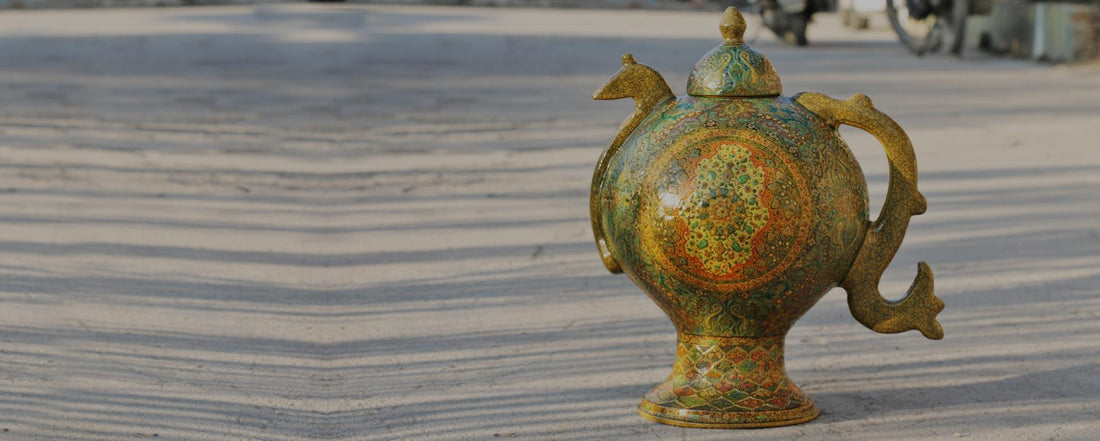My father Ghulam Hassan Jan taught me this art when I was 10years old. Paper Mache has been into our ancestry having been hand down from father to son since many generations. I have given my life to this art and now when I see what it has been reduced to, my heart aches. I love my work. It has been my true passion for all these years, since the day my father taught me to hold the qalam (pen) in hand.
The glory of Kashmir Art was such, that people would leave their government jobs to learn this art. Now, it’s another story altogether. People would now prefer to be daily wagers, working on bricks and kilns than have anything to do with this art. See how much has changed in these years! Tehreek, insurgency turned the fate of Kashmir upside down. We had so many tourists here from all over the world, which admired our art and craft and took pleasure in showcasing them in their homes abroad.
I remember we had many international clienteles prior to tehreek, who used to visit us and place an order with us. They would make advance payments and even pay for the freight charges. Such was the trust they had in Kashmir Artisans. We would then fulfill their order and dispatch the same to them once everything in their order was completed. That time was the Golden Era of Kashmir Art. Now it’s is all in shambles and ruins, and nobody cares about the situation we have landed ourselves in.
In all these years, even in all ups and downs, I never once thought of leaving this art. It has been my bread and butter. It was an exquisite art that was admired worldwide at the same time honoring the artisan as well. Compare it to today, neither the artisan is honored nor is the craft anymore admired except for maybe a few. There is no market for this art now.75% of our business has been lost. Whatever 25% is left is just the domestic market. The market has changed worldwide and I really don’t know who to put the blame on.
Like in every art, quality is what matters the most. paper mache does not go bad, nor do the colors ever fade. But there is now a decline in the quality as well. Poor material and colors are being used; B & C grade paper mache products have flooded the markets bringing down this precious hand art even more. You might think it is us, the artisans who are responsible And yes, even though we are a little to blame but there is nothing else we can doabout it. The price of our raw material is shooting to skies. We asked theCraft Development Institute to help us with the supply of raw materials. Withhardware prices on rise, our source requirement of varnish, colors and mouldsgets very heavy on our pockets. While the raw material is becoming expensive bythe day, the labor remains the same which in turn makes the product more expensive.
Then there is competition in this art. Even when I use A-qualityproducts, having never compromised on my art, I find little profit now. Other artisans,who are struggling to make their ends meet, sell their products barely makingany profit and the customer prefers that, a less expensive item, which in turnaffects every other artisan as well. The value of art goes down, quality goesdown and with that the entire Craft goes down. With minimum profit the raw materialused will of course be of an average quality. You can see where I am going withthis. It is a vicious cycle.
The government has turned a blind eye to the plight ofartisans. I sometimes wonder whether our condition would have been same if wewere born in some other more advanced and developed place, where there is accountabilityof every office. When I was young the government supported us. They sponsoredus in all exhibitions and art fairs across the country. I remember once we had anexhibition in Bombay (Mumbai). It was the year 1985. The government paid forall our travel, stay and even the freight charges. We had taken 7 baskets ofpaper Mache Items and Alhamdulillah we came back with nothing. In 7 days, I wason my toes with little time to spare for food and drinks. Even the wicker willowbaskets that we had our products in, we sold out on them as well! It was such a grand and learning experience for us. The organizers in Bombay on our lastnight took us out for sightseeing. ‘Bombay Night’ in a bus with dinner served, we Kashmiri artisans felt so welcome and enjoyed the whole 7 day trip while feelingall important and honored at that time.
Now compare that to another trip we took. I don’t remember theyear exactly but it was a decade later. It was again in Mumbai. This time thegovernment provided us with nothing except for the information and travelexpenses only. All the fright and stay charges were borne by us. The fair wasfor 15 days, but we came back with 75% of the products. With such little sale and the overwhelming fright charges both ways, there was no profit at all. We mighthave been running in loss, if anything else. The government left us to our own. Disheartened by little business, we sulked down to come back home. To add toour misery, the govt. which was supposed to bear our travel expenses could notarrange anything good for us. They had to bring us back in first class; insteadthey brought us back in ‘Chalu Dabba’, thelocal class. To add to the irony, wehad to contribute some money for that. It was days together from Mumbai toJammu, the most uncomfortable ride I have ever had in my life.
Frustrated by the treatment at the hands of our own people,we locked the compartment from inside. It was like a protest from our side.What happened after that, I will never forget in my life. I now laugh at it,but that time it was really hurtful. 43 artisans, locked in a compartment,bitter at the government, disheartened by the low sale, we all sat down, quietin the compartment. There was only one more family with us. They left us toourselves and said nothing when we locked the door. The compartment was next to the engine and allthe heat; we Kashmiri’s are not used to such high temperatures, it only addedto our frustration. People kept knocking at the door, at every stop, but no oneamong us wanted to open it. The family with us finally gave in to the bangs andopened the door in Delhi, at midnight. A whole gang of angry people burst in onus. Don’t even ask, what happened next. We were beaten to pulp. Finally when wereached Jammu, we were hungry, black and blue! Once we stopped there, we didnot even go to the rented rooms for freshening up, just went to an eating placeand started eating like beggars. That’s one trip none of us will ever forget,thanks to our government back then. Comparing the two trips, I feel amazed for how we were treated by strangers in Mumbai on our first trip and how our ownpeople treated us in the second one. Irony!
We as artisans also need to learn to keep up with the latesttrends of the world. We are still working on the primitive motifs when we needto bring in more contemporary designs to this art. New moulds, new designs arethe need of the hour. This should be done by the School of Design here. Weartisans are mostly illiterate and have a little know how of the outside world.If they could help us with newer things, I am sure we can turn over this craft.I have tried, made a little effort on my end and added some contemporary piecesof art, but how far can I go, all alone?
Kashmir Art has lost its precious glory. Now either there arefake replicas and substandard products everywhere or the real artisans havegiven up on the craft. My children never wanted to join me. They love the craftno doubt, but they have families and need to make ends meet. When I look atthis showroom of mine, I feel remorse over what time did to it and to us. Onceglorified it now craves an eye of admiration. When I die, I don’t know whatwill happen to this, my humble abode of art that my great great grandfather had started.

